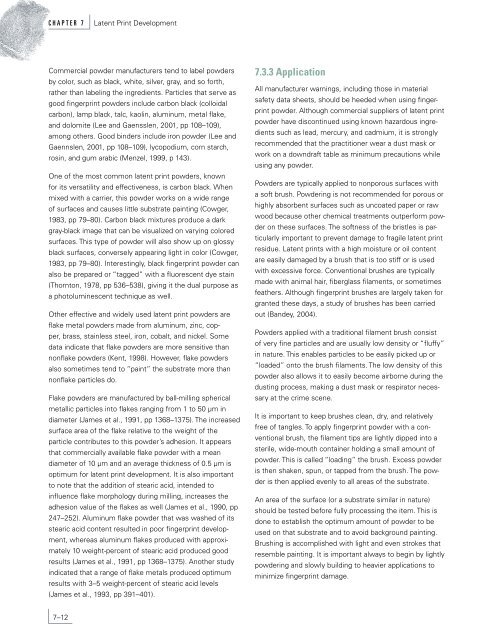Latent Print Development - National Criminal Justice Reference ...
Latent Print Development - National Criminal Justice Reference ...
Latent Print Development - National Criminal Justice Reference ...
You also want an ePaper? Increase the reach of your titles
YUMPU automatically turns print PDFs into web optimized ePapers that Google loves.
C H A P T E R 7 <strong>Latent</strong> <strong>Print</strong> <strong>Development</strong><br />
Commercial powder manufacturers tend to label powders<br />
by color, such as black, white, silver, gray, and so forth,<br />
rather than labeling the ingredients. Particles that serve as<br />
good fingerprint powders include carbon black (colloidal<br />
carbon), lamp black, talc, kaolin, aluminum, metal flake,<br />
and dolomite (Lee and Gaensslen, 2001, pp 108–109),<br />
among others. Good binders include iron powder (Lee and<br />
Gaennslen, 2001, pp 108–109), lycopodium, corn starch,<br />
rosin, and gum arabic (Menzel, 1999, p 143).<br />
One of the most common latent print powders, known<br />
for its versatility and effectiveness, is carbon black. When<br />
mixed with a carrier, this powder works on a wide range<br />
of surfaces and causes little substrate painting (Cowger,<br />
1983, pp 79–80). Carbon black mixtures produce a dark<br />
gray-black image that can be visualized on varying colored<br />
surfaces. This type of powder will also show up on glossy<br />
black surfaces, conversely appearing light in color (Cowger,<br />
1983, pp 79–80). Interestingly, black fingerprint powder can<br />
also be prepared or “tagged” with a fluorescent dye stain<br />
(Thornton, 1978, pp 536–538), giving it the dual purpose as<br />
a photoluminescent technique as well.<br />
Other effective and widely used latent print powders are<br />
flake metal powders made from aluminum, zinc, cop-<br />
per, brass, stainless steel, iron, cobalt, and nickel. Some<br />
data indicate that flake powders are more sensitive than<br />
nonflake powders (Kent, 1998). However, flake powders<br />
also sometimes tend to “paint” the substrate more than<br />
nonflake particles do.<br />
Flake powders are manufactured by ball-milling spherical<br />
metallic particles into flakes ranging from 1 to 50 μm in<br />
diameter (James et al., 1991, pp 1368–1375). The increased<br />
surface area of the flake relative to the weight of the<br />
particle contributes to this powder’s adhesion. It appears<br />
that commercially available flake powder with a mean<br />
diameter of 10 μm and an average thickness of 0.5 μm is<br />
optimum for latent print development. It is also important<br />
to note that the addition of stearic acid, intended to<br />
influence flake morphology during milling, increases the<br />
adhesion value of the flakes as well (James et al., 1990, pp<br />
247–252). Aluminum flake powder that was washed of its<br />
stearic acid content resulted in poor fingerprint develop-<br />
ment, whereas aluminum flakes produced with approxi-<br />
mately 10 weight-percent of stearic acid produced good<br />
results (James et al., 1991, pp 1368–1375). Another study<br />
indicated that a range of flake metals produced optimum<br />
results with 3–5 weight-percent of stearic acid levels<br />
(James et al., 1993, pp 391–401).<br />
7–12<br />
7.3.3 Application<br />
All manufacturer warnings, including those in material<br />
safety data sheets, should be heeded when using finger-<br />
print powder. Although commercial suppliers of latent print<br />
powder have discontinued using known hazardous ingre-<br />
dients such as lead, mercury, and cadmium, it is strongly<br />
recommended that the practitioner wear a dust mask or<br />
work on a downdraft table as minimum precautions while<br />
using any powder.<br />
Powders are typically applied to nonporous surfaces with<br />
a soft brush. Powdering is not recommended for porous or<br />
highly absorbent surfaces such as uncoated paper or raw<br />
wood because other chemical treatments outperform pow-<br />
der on these surfaces. The softness of the bristles is par-<br />
ticularly important to prevent damage to fragile latent print<br />
residue. <strong>Latent</strong> prints with a high moisture or oil content<br />
are easily damaged by a brush that is too stiff or is used<br />
with excessive force. Conventional brushes are typically<br />
made with animal hair, fiberglass filaments, or sometimes<br />
feathers. Although fingerprint brushes are largely taken for<br />
granted these days, a study of brushes has been carried<br />
out (Bandey, 2004).<br />
Powders applied with a traditional filament brush consist<br />
of very fine particles and are usually low density or “fluffy”<br />
in nature. This enables particles to be easily picked up or<br />
“loaded” onto the brush filaments. The low density of this<br />
powder also allows it to easily become airborne during the<br />
dusting process, making a dust mask or respirator neces-<br />
sary at the crime scene.<br />
It is important to keep brushes clean, dry, and relatively<br />
free of tangles. To apply fingerprint powder with a con-<br />
ventional brush, the filament tips are lightly dipped into a<br />
sterile, wide-mouth container holding a small amount of<br />
powder. This is called “loading” the brush. Excess powder<br />
is then shaken, spun, or tapped from the brush. The pow-<br />
der is then applied evenly to all areas of the substrate.<br />
An area of the surface (or a substrate similar in nature)<br />
should be tested before fully processing the item. This is<br />
done to establish the optimum amount of powder to be<br />
used on that substrate and to avoid background painting.<br />
Brushing is accomplished with light and even strokes that<br />
resemble painting. It is important always to begin by lightly<br />
powdering and slowly building to heavier applications to<br />
minimize fingerprint damage.

















